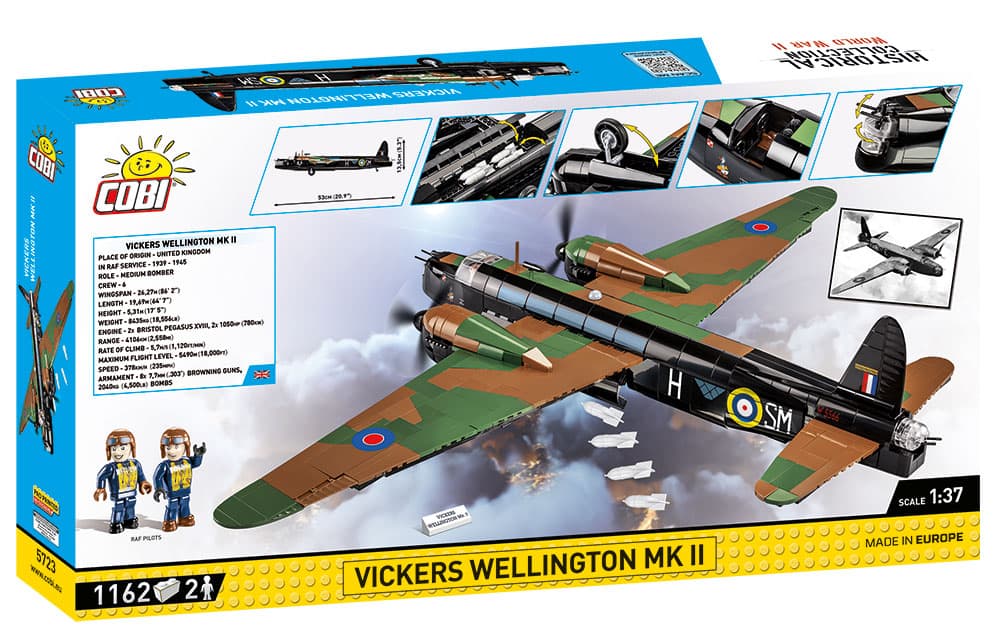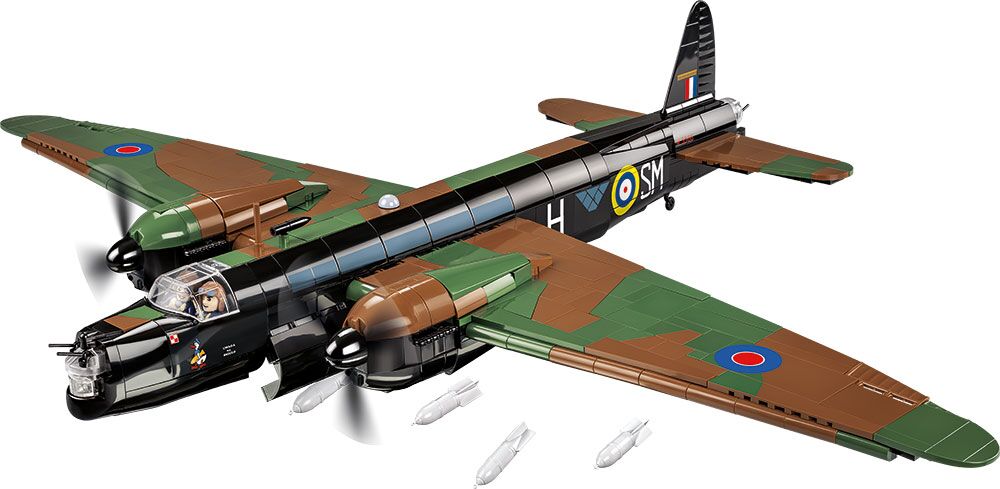Have a question or need customer support? Give us a call or text at 615-549-5441.
COBI Vickers Wellington MK II #5723 (discontinued)
$96.99
The Vickers Wellington was a British twin-engined, long-range medium bomber. It was designed during the mid-1930s at Brooklands in Weybridge, Surrey. Led by Vickers-Armstrongs’ chief designer Rex Pierson; a key feature of the aircraft is its geodetic airframe fuselage structure, which was principally designed by Barnes Wallis. Development had been started in response to Air Ministry Specification B.9/32, issued in the middle of 1932, for a bomber for the Royal Air Force.
This specification called for a twin-engined day bomber capable of delivering higher performance than any previous design. Other aircraft developed to the same specification include the Armstrong Whitworth Whitley and the Handley Page Hampden. During the development process, performance requirements such as for the tare weight changed substantially, and the engine used was not the one originally intended.
The Wellington was used as a night bomber in the early years of the Second World War, performing as one of the principal bombers used by Bomber Command. During 1943, it started to be superseded as a bomber by the larger four-engined “heavies” such as the Avro Lancaster. The Wellington continued to serve throughout the war in other duties, particularly as an anti-submarine aircraft.
It holds the distinction of having been the only British bomber that was produced for the duration of the war, and of having been produced in a greater quantity than any other British-built bomber. The Wellington remained as first-line equipment when the war ended, although it had been increasingly relegated to secondary roles.
https://en.wikipedia.org/wiki/Vickers_Wellington
Out of stock
Notify me when the item is back in stock.
This product has been discontinued by Cobi and will be decommissioned when stock runs out.
Description
The Vickers Wellington was a British twin-engined, long-range medium bomber. It was designed during the mid-1930s at Brooklands in Weybridge, Surrey. Led by Vickers-Armstrongs’ chief designer Rex Pierson; a key feature of the aircraft is its geodetic airframe fuselage structure, which was principally designed by Barnes Wallis. Development had been started in response to Air Ministry Specification B.9/32, issued in the middle of 1932, for a bomber for the Royal Air Force.
This specification called for a twin-engined day bomber capable of delivering higher performance than any previous design. Other aircraft developed to the same specification include the Armstrong Whitworth Whitley and the Handley Page Hampden. During the development process, performance requirements such as for the tare weight changed substantially, and the engine used was not the one originally intended.
The Wellington was used as a night bomber in the early years of the Second World War, performing as one of the principal bombers used by Bomber Command. During 1943, it started to be superseded as a bomber by the larger four-engined “heavies” such as the Avro Lancaster. The Wellington continued to serve throughout the war in other duties, particularly as an anti-submarine aircraft.
It holds the distinction of having been the only British bomber that was produced for the duration of the war, and of having been produced in a greater quantity than any other British-built bomber. The Wellington remained as first-line equipment when the war ended, although it had been increasingly relegated to secondary roles.
https://en.wikipedia.org/wiki/Vickers_Wellington
Video Intel
Below are very informative and entertaining videos to discover more about this unit and it’s place in history. Please be aware that some of these videos may contain crude language and/or actual footage of warfare. This may be disturbing to sensitive or young viewers. We have selected the videos for their historical context in relation to our products for the purpose of research and learning.
Product Specifications
Additional information
| Weight | 42.4 oz |
|---|---|
| Dimensions | 17.72 × 2.75 × 12.6 in |
| Number of Pieces | 1162 |
| Scale | 1:48 |
Product Reviews
Other Great Products
Related products
-
COBI Vought F4-U-4 Corsair #2417
Rated 5.00 out of 5$59.99 Add to cart - Sale!
COBIMiG-17 NATO Code “Fresco” (N. Vietnam) #2424
$63.99Original price was: $63.99.$39.99Current price is: $39.99. Add to cart -
Top Gun F-14 Tomcat #5811-A
Rated 5.00 out of 5$79.98 Add to cart -
COBI Rafale C Fighter Aircraft #5802
Rated 5.00 out of 5$44.98 Add to cart
Stay Up To Date!
Sign up below to be notified when new products or exciting promotions are being offered.












Reviews
There are no reviews yet.